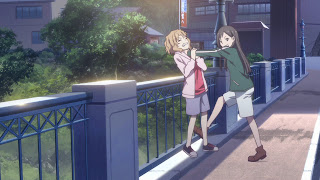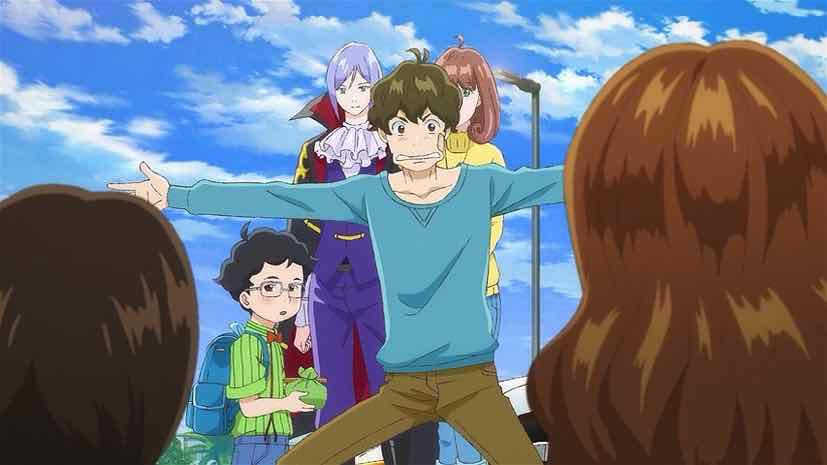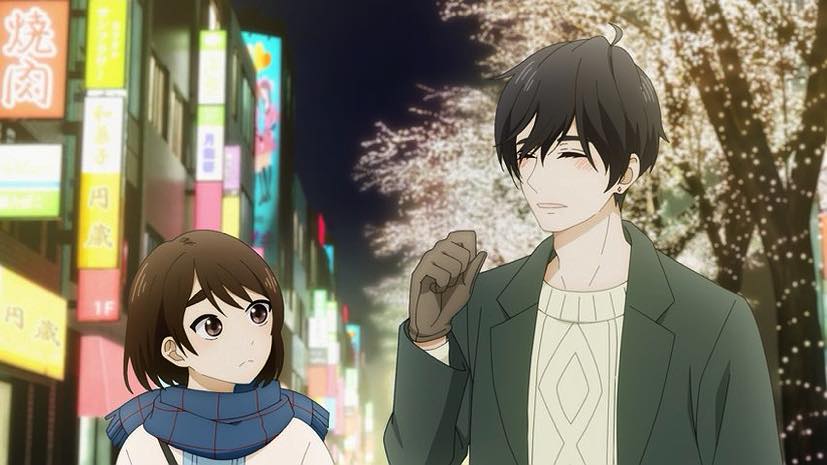I’ll admit I was a little worried after last week’s wayward episode, which felt like a completely different series had possessed the one I’d grown to admire so much after two episodes. But based on this week, I needn’t have – unless Hanasaku Iroha has one of the biggest cases of multiple personality disorder ever. Episode 4 was absolutely stellar from start to finish.
There are a lot of different things happening in this story, which seems to be a common recurring thread among Mari Okada’s adaptations. While it’s most overtly about Ohana’s quest for self-discovery, it’s also a really interesting fish-out-of-water tale about her adapting to small-town life. It’s a romance, it’s a study of village life itself, a commentary on family relationships and family businesses. And what’s more, all of these aspects are just about equally interesting. The one dead-end so far has been Jiro, the “novelist” – and after last week’s disastrous ep devoted entirely to him (apart from the brilliant last two minutes) the reverse happens this time – he’s around for two minutes, then blissfully forgotten for the remaining twenty.
 I loved Ohana’s reaction to the grey heron – “Aren’t they usually at the zoo?” That animal represents more than just an animal – but equally spot-on was the reaction of the small-town kids in Ohana’s homeroom to the fact that she was from Tokyo. There’s a real clash happening here – between a rural and urban view of life that are mutually incompatible, and very often at odds in today’s Japan. Ohana also has an internal clash going on, between her fascination with the simple pleasures of her new life and the pull of her old life in Tokyo. I can’t help but feel for Ko-chan – it’s obvious that there was something very real between he and Ohana, but she’s left him behind through no fault of his own – at least for now. Can someone grow without growing apart from the person they loved before? An interesting question, and one we haven’t seen the last of in this series I’m sure.
I loved Ohana’s reaction to the grey heron – “Aren’t they usually at the zoo?” That animal represents more than just an animal – but equally spot-on was the reaction of the small-town kids in Ohana’s homeroom to the fact that she was from Tokyo. There’s a real clash happening here – between a rural and urban view of life that are mutually incompatible, and very often at odds in today’s Japan. Ohana also has an internal clash going on, between her fascination with the simple pleasures of her new life and the pull of her old life in Tokyo. I can’t help but feel for Ko-chan – it’s obvious that there was something very real between he and Ohana, but she’s left him behind through no fault of his own – at least for now. Can someone grow without growing apart from the person they loved before? An interesting question, and one we haven’t seen the last of in this series I’m sure.
I’m not crazy about Nako as a character – her whispering timidity is annoyingly trite and she feels like the least interesting person in the cast. But Minchi is growing in stature as the series progresses. You can’t help but root for Ohana in her quest to build a relationship with her – and let’s face it, this is anime so you know they’ll eventually be friends – but at the same time, I just want to tell Ohana to back the Hell off. Her quality of rarely having an unspoken thought gets her in so much trouble with Minchi, with whom she seems to have a magical gift for saying the wrong thing. Of course it never occurs to her until it’s too late that Tohru is the one Minchi likes – leading to the hilarious scene in the bath – but she then compounds her mistake by just not letting it go. It’s the impatience of youth, I suppose – wanting to make things right immediately without thinking of the consequences. But if youth is wasted on the young, patience is surely wasted on the old.
 I can’t write this without touching on the beautiful look of the show here. Backgrounds, animation, character design – all off the charts. This show is delivering some of the loveliest visuals of any TV anime since Seirei no Moribito. P.A. Works has delivered gorgeous animation before – True Tears certainly comes to mind – but I think this may even be a touch better. The village setting is conveyed with such realism and detail that it feels as if you’re watching a movie at times. The heron, the sakura, the shrine – at times this week I found myself gasping, pausing and rewinding just to savor the sights one more time. Director Masahiro Ando’s finest work is the lavishly beautiful feature film Sword of the Stranger, and he clearly knows how to take all that gorgeous art and use it to its full advantage. I still rank AnoHana as the best show of the season, but with a few more eps like this week Hanasaku Iroha is going to make that a tough call.
I can’t write this without touching on the beautiful look of the show here. Backgrounds, animation, character design – all off the charts. This show is delivering some of the loveliest visuals of any TV anime since Seirei no Moribito. P.A. Works has delivered gorgeous animation before – True Tears certainly comes to mind – but I think this may even be a touch better. The village setting is conveyed with such realism and detail that it feels as if you’re watching a movie at times. The heron, the sakura, the shrine – at times this week I found myself gasping, pausing and rewinding just to savor the sights one more time. Director Masahiro Ando’s finest work is the lavishly beautiful feature film Sword of the Stranger, and he clearly knows how to take all that gorgeous art and use it to its full advantage. I still rank AnoHana as the best show of the season, but with a few more eps like this week Hanasaku Iroha is going to make that a tough call.




